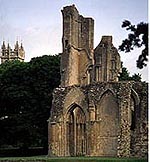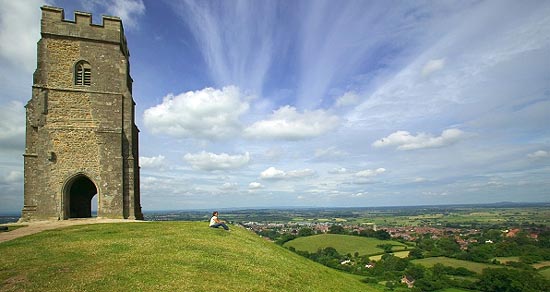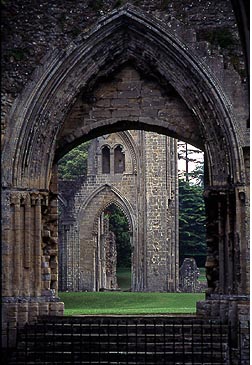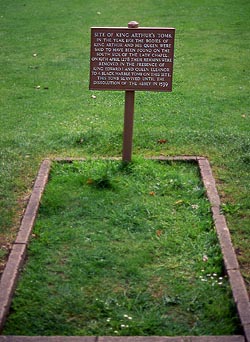Glastonbury Tor: Where Legend and History Meet
by Susan Wilbanks
 Glastonbury Tor rises like a beacon above the Somerset levels. Visible for over twenty miles, it floats like an island over the misty, verdant landscape. There's something almost mystical about this hill and the ghostly tower atop it. Even if you're not there on pilgrimage, when you catch sight of Glastonbury you'll understand its allure for pagan and Christian alike.
Glastonbury Tor rises like a beacon above the Somerset levels. Visible for over twenty miles, it floats like an island over the misty, verdant landscape. There's something almost mystical about this hill and the ghostly tower atop it. Even if you're not there on pilgrimage, when you catch sight of Glastonbury you'll understand its allure for pagan and Christian alike.
In Glastonbury, legend and history meet. The reality is straightforward: a majestic ruined abbey and church set in a charming, offbeat English town unique for its sheer number of New Age and magic shops. But behind the facts lurk legends of Arthur, the Holy Grail, and even the idea that a young Jesus may have visited Britain.
Glastonbury Tor
In ancient times, the Somerset levels were a shallow, marshy sea. Then, Glastonbury Tor was an island. Neolithic peoples in the region built platform villages linked by wooden causeways, arguably the first man-made roads.
At some point, no one knows exactly when, the Tor became a sacred site. Viewed close up, its slopes are subtly terraced, and some scholars speculate that it forms a remnant of a Neolithic labyrinth. The Celts called it Ynys Witrin, or the Isle of Glass, and believed it was a gateway to the underworld. Later legend has it that the Tor is the Island of Avalon, burial site of King Arthur.

The tower on the Tor is all that remains of a fourteenth-century chapel dedicated to Saint Michael, a replacement for an earlier church destroyed by an earthquake in 1275. The chapel is in itself evidence of the site's pre-Christian roots. It was a common practice to build churches on pagan worship sites both to cement the ascendancy of the new faith and to give the people a Christian gathering place at a familiar spot. Such churches were often dedicated to Michael in his role as spiritual guardian.
As long as you're in fairly good shape, climbing the Tor is an essential part of any visit to Glastonbury. It's a steady climb, not too steep, to the top of the 500-foot hill. Allow about half an hour for the climb.
You're unlikely to actually be alone atop the Tor, but your fellow travelers won't spoil the essential solitude of the experience. Gaze out on the sweeping expanse of Somerset countryside framed by the arches of St. Michael's Tower. Take some time to sit on the hillside and imagine everyone who came before you, all the pagans and Christians, the Saxons, Romans, Celts, and Neolithic peoples. And if you're here on a pilgrimage, there's no better place to offer a prayer.
The Holy Grail
 The next piece of Glastonbury's legendary past concerns the earliest foundations of British Christianity.
The next piece of Glastonbury's legendary past concerns the earliest foundations of British Christianity.
In the Bible, Joseph of Arimathea is accorded brief mention as a member of the religious council who argued against Jesus' crucifixion, claimed his body from the cross, and buried him in his own tomb. The Grail legend gives him a more prominent role.
The tale has it that Joseph was an uncle of Jesus and also a merchant who traveled to Roman Britain as part of the lead trade centered on the Mendip Hills near Glastonbury. He took the young Jesus on one of his trading expeditions, an event alluded to in William Blake's hymn Jerusalem: "And did those feet in ancient time/Walk upon England's mountains green?/And was the holy Lamb of God/On England's pleasant pastures seen?"
Decades later, Joseph returned to Britain with a missionary party and a relic unlike any other: the chalice used by Jesus and his disciples at the Last Supper. Landing at Glastonbury, he built Britain's first church, a small wattle-and-daub building on what would later become the grounds of the Abbey. The Glastonbury Thorn on Wearyall Hill southwest of town grew where he planted his staff, and he hid the Grail somewhere in the Chalice Well, a spring near the base of the Tor.
Whatever the truth behind the Grail stories, Glastonbury undoubtedly is a significant early Christian site. Glastonbury Abbey, located in the center of town below the Tor, dates at least to 601, and past excavations suggest that a Celtic monastery stood on the Tor itself in the fifth and sixth centuries.
The Benedictine monastery quickly became an important center of learning, and the town grew up around it. By the time of the Domesday Book in 1086, Glastonbury Abbey was England's wealthiest, though it would later be eclipsed by Westminster Abbey. Its buildings and grounds were magnificent, and its abbots wielded extensive worldly as well as spiritual power.
 The Abbey's prestige was enhanced in 1190 when monks discovered bones they claimed to be those of Arthur and Guinevere buried on the grounds. They were later reburied in great state before the high altar of the Abbey church. Not surprisingly, Glastonbury became a popular destination for medieval pilgrims.
The Abbey's prestige was enhanced in 1190 when monks discovered bones they claimed to be those of Arthur and Guinevere buried on the grounds. They were later reburied in great state before the high altar of the Abbey church. Not surprisingly, Glastonbury became a popular destination for medieval pilgrims.
All this splendor came to an end in 1539 when Henry VIII dissolved the monasteries. The abbey was plundered for its riches -- including Arthur and Guinevere's purported remains, which have been lost to history -- and it fell into ruin.
When you tour the Abbey, begin in the Visitor's Centre. It includes a museum that provides an excellent overview of the history of the site and explains what each ruin once was. Be sure to look at the model of what the Abbey might have looked like immediately prior to its dissolution. Once you're on the grounds, pay special attention to the best-preserved building, the fourteenth-century Abbot's Kitchen. There whole oxen and the like were roasted to feed the abbot and distinguished pilgrims and guests. It had four fireplaces, and the high point of its 72-foot octagonal roof was once fitted with adjustable shutters designed to allow smoke to escape in the opposite direction of the wind.
The Abbey has once again become an active place of worship. Weekly Anglican services are held on the grounds, often in St. Patrick's Chapel, an intact building constructed around 1500. The second weekend of July is a special time of pilgrimage for Anglican, Orthodox, and Catholic Christians. The faithful take communion on the site of the Abbey church, venerate an icon of Our Lady of Glastonbury, parade through the town, and hear evensong among the ruins.
Other Sights
In the Chalice Well and Gardens at the foot of the Tor, you can drink from an ancient spring that, like so much of Glastonbury, is sacred to pagans and Christians alike. Did Joseph of Arimathea really hide the Grail there? Who knows? But it's a tranquil spot that has been visited and revered for centuries.
St. Benedict's Church and St. John's Church are the town's medieval parish churches, both built in the Perpendicular style.
The Tourist Information Centre is located in the Glastonbury Tribunal, a fifteenth-century merchant's house. Also in the Tribunal is the Lake Village Museum, detailing everyday life in Somerset's Iron Age settlements.
The Somerset Rural Life Museum, located in the Abbey's farmhouse and tithe barn, tells the story of Victorian farm life by following a fictional farm worker, John Hodge, from cradle to grave. The fourteenth-century tithe barn is worth visiting for its architecture alone, and the museum hosts frequent craft demonstrations and workshops.
If You Go
Glastonbury is an easy day trip for tourists based in Bath or Bristol. It has no train service, but an hourly bus connects it to Bristol and Wells, with slightly less frequent service to and from Bath.
Glastonbury's major sights can be viewed in a day. If you only have a few hours, spend them at the Abbey and on the Tor. If you choose to stay overnight, the town offers an extensive array of B&B accommodations and several campgrounds. While staying in the area, history buffs might consider visiting Cheddar Gorge, the cathedral town of Wells, and the Peat Moors Centre in Westhay, which offers further insight into Somerset's prehistoric, Celtic, and Roman history and archeology.
The annual Glastonbury Festival takes place a few miles from town in late June. It's the world's largest greenfield music and performing arts festival. Depending on your interests and tolerance for crowds, it could be the best time to go, or the one weekend you'll want to be sure to stay away!
If your travels take you to southwest England, make time for Glastonbury. Come face to face with its realities, and dream of its legends.
More Information:
We regret that we no longer have the resources to maintain up-to-date links and/or hours and pricing details for the various sites and attractions listed on this website. For more information about the location(s) listed above, please use your favorite search engine or visit Wikipedia.
Susan Wilbanks is a freelance writer who lives in Seattle with her husband, baby daughter, and extensive book collection. In 1997-98, she lived and worked in Bristol and spent as much time as possible exploring the rich history of the surrounding area. As an aspiring romance writer, she also puts her love of British history to use in her fiction. She'd jump at the chance to live in England again, although she'd go into baseball withdrawal at the separation from her beloved Mariners.
Article © 2005 Susan Wilbanks
Abbey Photos © 2003 British History Club (Britannia.com); Glastonbury Tor photo © VisitBritain.com
| 